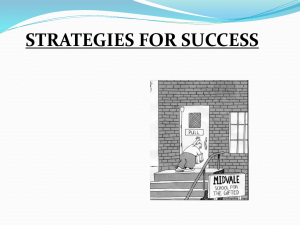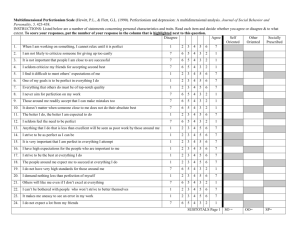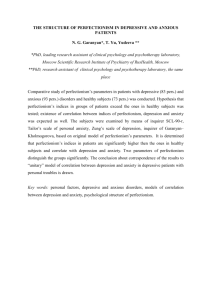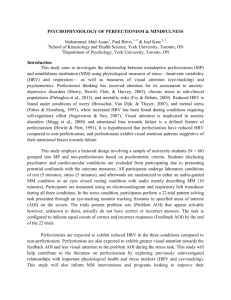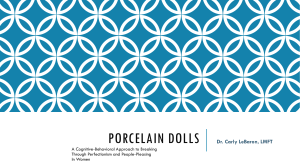1 Book Review Monica Ramirez Basco. Never Good Enough: How
advertisement
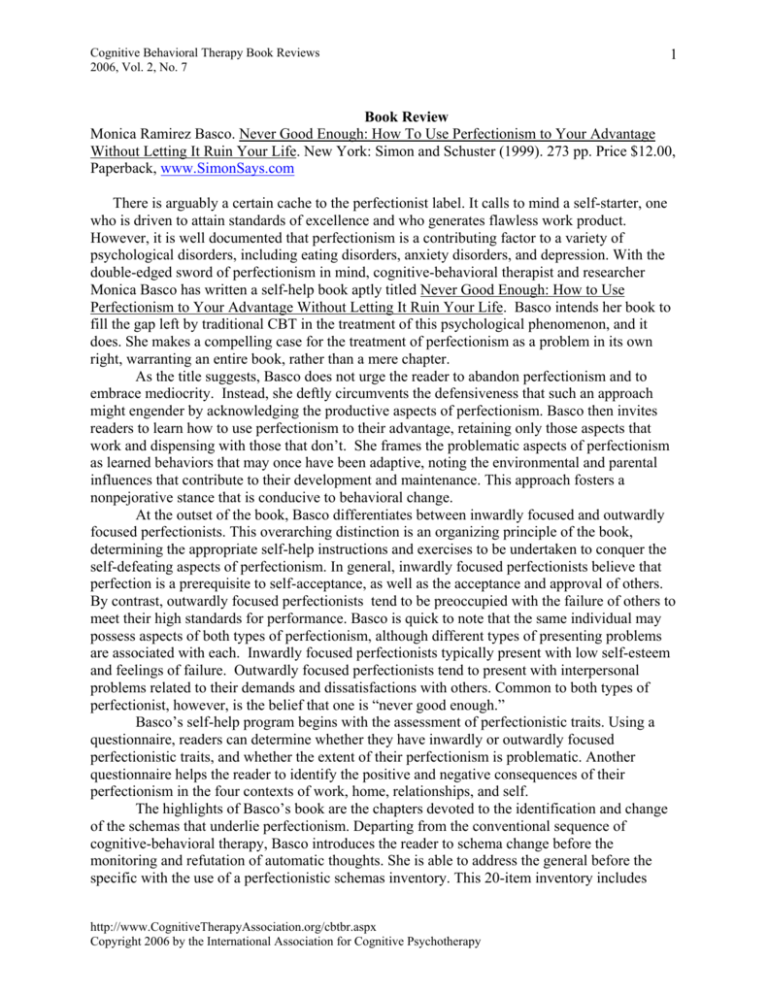
Cognitive Behavioral Therapy Book Reviews 2006, Vol. 2, No. 7 1 Book Review Monica Ramirez Basco. Never Good Enough: How To Use Perfectionism to Your Advantage Without Letting It Ruin Your Life. New York: Simon and Schuster (1999). 273 pp. Price $12.00, Paperback, www.SimonSays.com There is arguably a certain cache to the perfectionist label. It calls to mind a self-starter, one who is driven to attain standards of excellence and who generates flawless work product. However, it is well documented that perfectionism is a contributing factor to a variety of psychological disorders, including eating disorders, anxiety disorders, and depression. With the double-edged sword of perfectionism in mind, cognitive-behavioral therapist and researcher Monica Basco has written a self-help book aptly titled Never Good Enough: How to Use Perfectionism to Your Advantage Without Letting It Ruin Your Life. Basco intends her book to fill the gap left by traditional CBT in the treatment of this psychological phenomenon, and it does. She makes a compelling case for the treatment of perfectionism as a problem in its own right, warranting an entire book, rather than a mere chapter. As the title suggests, Basco does not urge the reader to abandon perfectionism and to embrace mediocrity. Instead, she deftly circumvents the defensiveness that such an approach might engender by acknowledging the productive aspects of perfectionism. Basco then invites readers to learn how to use perfectionism to their advantage, retaining only those aspects that work and dispensing with those that don’t. She frames the problematic aspects of perfectionism as learned behaviors that may once have been adaptive, noting the environmental and parental influences that contribute to their development and maintenance. This approach fosters a nonpejorative stance that is conducive to behavioral change. At the outset of the book, Basco differentiates between inwardly focused and outwardly focused perfectionists. This overarching distinction is an organizing principle of the book, determining the appropriate self-help instructions and exercises to be undertaken to conquer the self-defeating aspects of perfectionism. In general, inwardly focused perfectionists believe that perfection is a prerequisite to self-acceptance, as well as the acceptance and approval of others. By contrast, outwardly focused perfectionists tend to be preoccupied with the failure of others to meet their high standards for performance. Basco is quick to note that the same individual may possess aspects of both types of perfectionism, although different types of presenting problems are associated with each. Inwardly focused perfectionists typically present with low self-esteem and feelings of failure. Outwardly focused perfectionists tend to present with interpersonal problems related to their demands and dissatisfactions with others. Common to both types of perfectionist, however, is the belief that one is “never good enough.” Basco’s self-help program begins with the assessment of perfectionistic traits. Using a questionnaire, readers can determine whether they have inwardly or outwardly focused perfectionistic traits, and whether the extent of their perfectionism is problematic. Another questionnaire helps the reader to identify the positive and negative consequences of their perfectionism in the four contexts of work, home, relationships, and self. The highlights of Basco’s book are the chapters devoted to the identification and change of the schemas that underlie perfectionism. Departing from the conventional sequence of cognitive-behavioral therapy, Basco introduces the reader to schema change before the monitoring and refutation of automatic thoughts. She is able to address the general before the specific with the use of a perfectionistic schemas inventory. This 20-item inventory includes http://www.CognitiveTherapyAssociation.org/cbtbr.aspx Copyright 2006 by the International Association for Cognitive Psychotherapy Cognitive Behavioral Therapy Book Reviews 2006, Vol. 2, No. 7 2 conditional beliefs concerning the consequences of making of mistakes--failure, rejection, humiliation, as well as conditional beliefs that reflect the fantasized outcomes associated with the attainment of perfection— inner peace and acceptance by others. Motivation to change these beliefs is developed by weighing their relative advantages and disadvantages. To assist in the process of schema change, standard cognitive-behavioral exercises, such as weighing experiences that support and contradict these beliefs, are prescribed. However, to tackle the beliefs about existential outcomes associated with the attainment of perfection, such as inner peace or self- acceptance, Basco takes a different approach. Diverting the reader from the often unattainable goal of perfection, she suggests beginning the process of making real-world changes, including the removal of current obstacles to inner peace and self-acceptance, i.e., changing the things one does not like about oneself. Basco introduces the concepts of automatic thoughts and thinking errors midway through Never Good Enough. The primary cognitive distortions she identifies in perfectionism are magnification, minimization, mind reading, fortune telling, jumping to conclusions, tunnel vision, and oversimplification. Rather than introduce the use of thought records for recording and refuting distorted automatic thoughts, Basco details each type of cognitive distortion separately, and prescribes various exercise to counter these distortions. For example, Basco has observed the tendency of perfectionists to view small positive events or small accomplishments as insignificant. She points out that “life is generally made up of lots of small positive events,” and that “to ignore the small ones is to be unhappy . . . much of the time.” To remedy this, Basco instructs the reader to reflect on the small positive events that have occurred at the end of each day. By keeping a list, readers have the opportunity to see the incremental effect of these small events. Basco asserts that oversimplification or dichotomous thinking is the most common cognitive distortion in perfectionism, and therefore devotes an entire chapter to its treatment. The primary technique used to move the reader from a black and white view of the world to one that includes shades of gray is the cognitive continuum. Basco observes the tendency of the perfectionist to view any performance short of perfection as failure. Accordingly, readers are instructed to break an area of unsatisfactory performance into its component parts, and to evaluate their performance in each using a continuum of 0 to 100% success. Basco compels the reader to make the nebulous standards of perfection and failure explicit by defining the endpoints of the scale in behavioral terms. Readers are then asked to designate acceptable levels of success and to compare these with actual performance ratings to identify areas where they may be exerting unnecessary effort by exceeding acceptable performance levels. In this way, readers who tend to view all tasks as equally important learn to develop priorities and re-assess performance expectations. Seemingly at odds with efforts elsewhere in the book to combat dichotomous thinking are the two chapters that concern the interpersonal problems posed by perfectionism. These chapters offer advice to the “perfectionist” for dealing with the “non-perfectionist,” and visa versa, as if the world can be readily divided into these two mutually exclusive categories. Basco does point out to perfectionists their tendencies to label others, to mind-read, to assume their standards are universal, and to personalize the mistakes of others. However, it seems that greater emphasis could be placed on helping the self-identified perfectionist to understand that their difficulty tolerating the mistakes of others stems from difficulty in tolerating their own mistakes. Never Good Enough is an important contribution to the cognitive-behavioral therapy of perfectionism. Although written as a self-help guide, clinicians will find it very useful in working http://www.CognitiveTherapyAssociation.org/cbtbr.aspx Copyright 2006 by the International Association for Cognitive Psychotherapy Cognitive Behavioral Therapy Book Reviews 2006, Vol. 2, No. 7 3 with clients. Particularly valuable is the perfectionistic schema questionnaire, which makes short work of identifying the core beliefs that underlie so many presenting problems. A minor frustration for clinicians seeking to integrate Basco’s book into their evidence-based practice, and perhaps for lay readers as well, are the allusions to research that is never explicitly cited. Other minor frustrations are the book’s paperback rather than workbook format, and the lack of an appendix with reproducible worksheets. One can only hope that Basco is contemplating the reissuance of this incredibly insightful book in workbook format. Lisa Napolitano, Ph.D. American Institute for Cognitive Therapy New York, NY http://www.CognitiveTherapyAssociation.org/cbtbr.aspx Copyright 2006 by the International Association for Cognitive Psychotherapy

